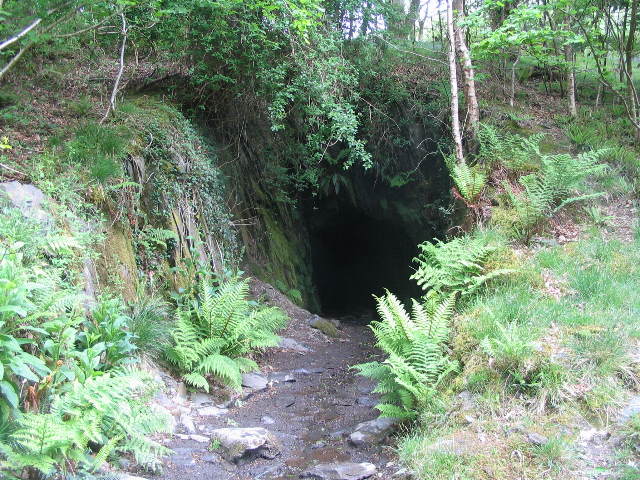Introduction
Quarried from the same beds as Bryneglwys, a short lived quarry that was worked on a small scale. The Dolgoch station on the Talyllyn Railway was conveniently close for loading slate from the quarry.
Adits
There were four adits located between SH652044 and SH655043, details taken from Wikipedia:
Adit 1 is located close to the Lower Dolgoch Falls. It is approximately 30m long and dog-legs to the right slightly, ending at a chamber that is open to the sky, but fenced off for safety.
The other three adits are on the level above the Lower Falls, and along the walkway to the Middle Dolgoch Falls.
Adit 2 is very wet for most of its length, although it gets drier towards the end. It is approximately 10mm long and bends towards the left slightly as you go in.
Adit 3 is the shortest, as it is only 20m long.
Adit 4 is the longest and most complexly-shaped. It twists and turns mostly to the left until, approximately 70m away from the entrance, it divides into two. The left-hand branch goes approximately 25m further from the junction. The right-hand branch goes approximately 100m further after the junction. Part-way along the right-hand branch, about 30m from the junction, there is a narrow drive, around 5m long, to the left.
Geology
From Wikipedia:
Three parallel veins of Ordovician slate run through mid Wales, from the region north of Dinas Mawddwy through Corris and south west towards Tywyn: the Broad Vein; the Red Vein or ‘‘Middle Vein’’ (sometimes considered to be part of the Broad Vein); and the Narrow Vein. These veins are the southern edge of the Harlech Dome anticline which surfaces in the north at Blaenau Ffestiniog. The Dolgoch quarry worked the Broad Vein and the Narrow Vein; these are the same two veins that were more successfully worked at the Bryn-Eglwys quarry around 1.5km west.
The widest of these veins is the 200m thick ‘‘Broad Vein’’ that lies to the north of the site and consists of layers of hard, grey shale with patches of slate. The Broad Vein slate is hard and durable, but does not split into thin sections, so is generally unsuitable for use as Roofing slate.
The ‘‘Middle Vein’’ (also known as the ‘‘Red Vein’’) lies about 30m south of the Broad Vein. It is about 20m thick but contains low-quality, friable slate that contains a large number of fossils, predominately graptolites. This vein was not worked commercially at Dolgoch. The British Geological Survey now considers the Middle Vein to be a part of the Broad Vein, not a separate formation.
The third vein is the ‘‘Narrow Vein’’ which lies about 100 yards south of the Middle Vein and is also about20m thick. It contains the highest quality slate of the three veins and the most commercially valuable, being easy to split into roofing slates and slabs and both durable and strong. The vein is mostly a continuous bed of slate, containing only the occasional seam of quartz. However the quality of the rock varies over the depth of the vein; the best material is found nearest the surface.
| Year | Activity |
|---|---|
| 1868 | W.W. Jones, a local mine prospector leased land in the Dolgich Ravine |
| 1872 | Lease given to to Dolgoch Slate and Slab Company Ltd, who intended to raise £30,000 to buy the quarry. A lease of 40 years at £30 pa was granted by landowner Athelstan John Soden Corbet (who was in debt) |
| 1875 | Quarry opens. |
| 1878 | Athelstan Corbet’s estate auctions, Dolgoch Farm on which quarry stands sold to Edward Lyon of Scrigford. |
| 1880 | Major storm damages quarry. |
| 1884 | Quarry closed. |
| 1897 | Newly formed Dolgoch Slate Limited attempts to secure 25 year lease, Robert John Roberts, the landowner did not agree on the lease, so revival abandoned. |
| 1902 | Sold by Roberts to Tywyn Urban District Council, quarrying prohibited under sale terms. |
| 1910 | Attempt to re-open by Bryn Eglwys workers after Bryn Eglwys closure. |



